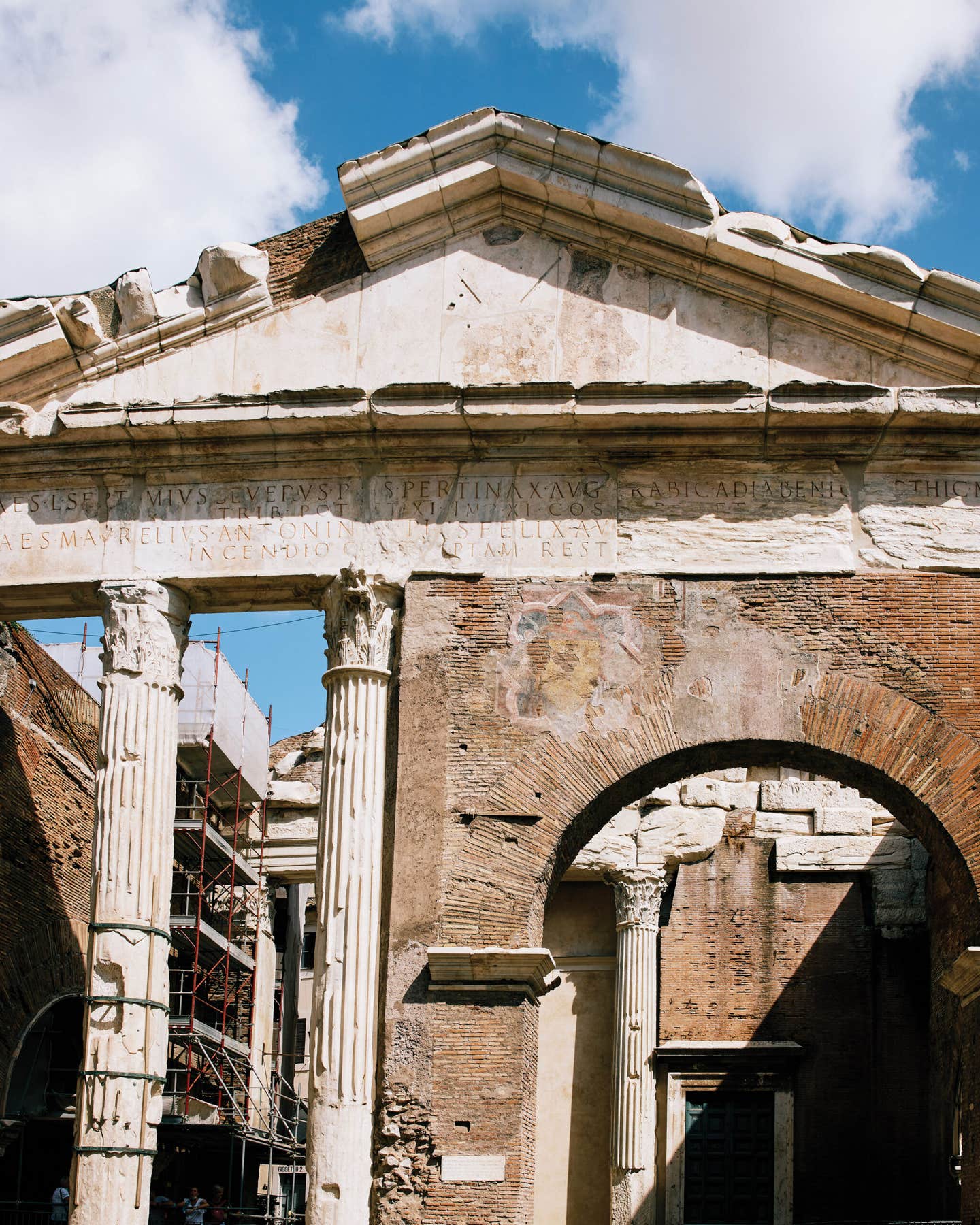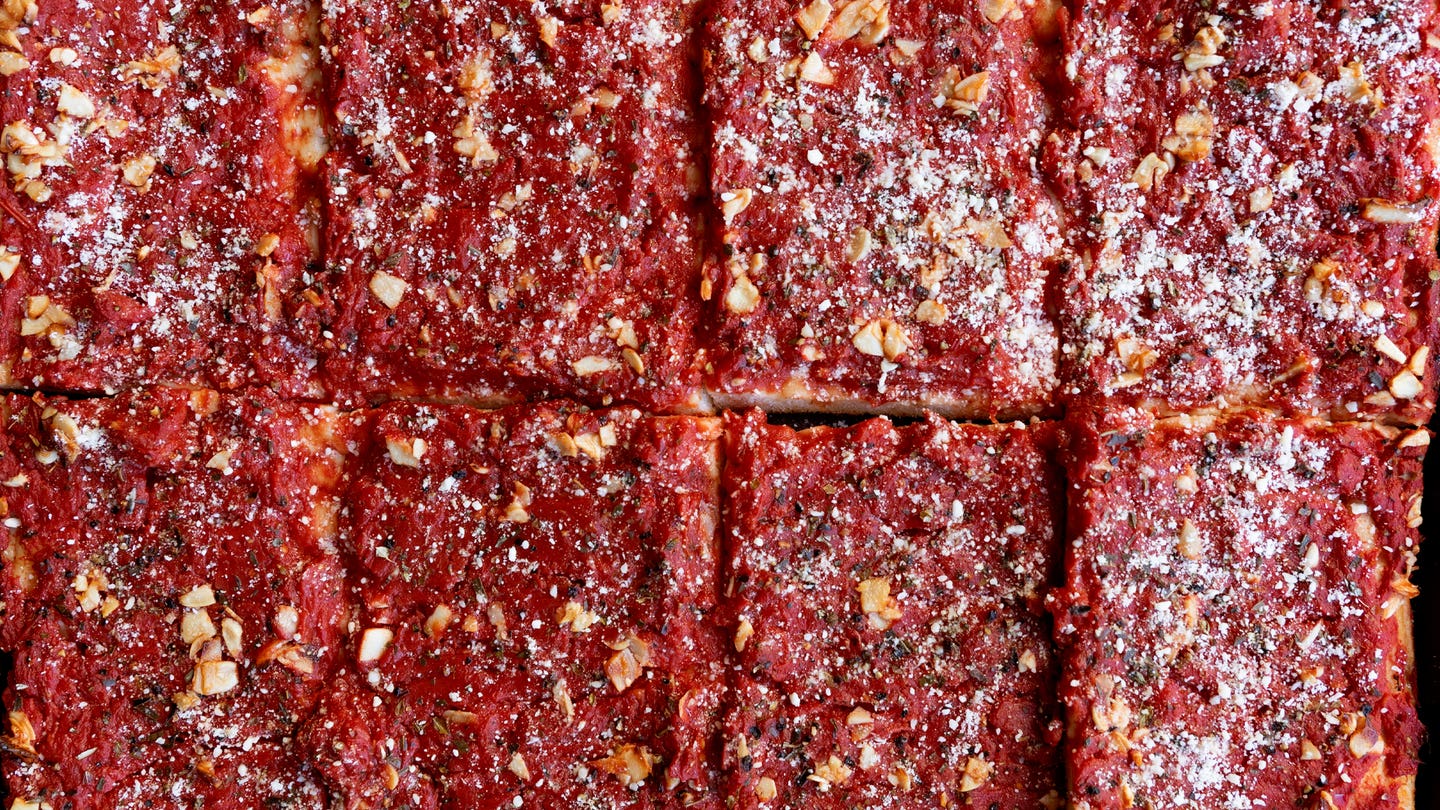This Cookbook Is a Must-Read Love Letter to Roman Jewish Cuisine
A conversation with ‘Portico’ author Leah Koenig reveals the dishes of this culinary hotbed that are hiding in plain sight.

This story is brought to you by SAVEUR Cookbook Club, our passionate community of food-loving readers from around the globe celebrating our favorite authors and recipes. Join us as we cook through a new book every month, and share your food pics and vids on social media with the hashtags #SAVEURCookbookClub and #EatTheWorld.
When I asked Leah Koenig to take me on a virtual walk down the Via del Portico d’Ottavia, a single city block in Rome, I could tell even via our choppy video connection that her eyes lit up with delight. Koenig has spent the last three-plus years of her career steeped in the intricacies of Roman Jewish cuisine, and in the course of her research, she’s come to understand this street not only in its bustling present-day activities, but also in its past struggles. The street once functioned as the demarcating line around the Jewish Ghetto, in which the Jewish community of Rome was forced to live by papal decree from 1555 to 1849. “During that period it resembled the worst of conditions,” Koenig said, “Super-cramped and super-dark. The structures were built slip-shod, with no room to expand horizontally, so there was no sunlight.” Yet Koenig notes that despite the hardships of daily life in the Ghetto, it also served as a vital site of Jewish culture and cuisine. Today, visitors can walk through the remains of the razed Ghetto while also visiting the Tempio Maggiore, the still-functioning domed synagogue built in 1904 that features a renowned museum on the Jewish experience. And the Via del Portico d'Ottavia, the street that functions as the historical and cultural spine of the Roman Jewish experience, is as present in Koenig’s mind as it is specifically and lovingly described in her new book, Portico: Cooking and Feasting in Rome's Jewish Kitchen.
As Koenig details in her book, the Roman Jewish experience began in the second century BCE, when the earliest Jews arrived as diplomatic envoys of Judah Maccabee. Today the Roman Jewish population is composed of three distinct Jewish communities—the Italkim, the Sephardim, and Libyan Jews—who contributed specific ingredients, techniques, and dishes to the Roman culinary canon. Because of the breadth of recipes in the book, it includes not only many dishes familiar to any fan of Roman cuisine, but also many connections to the broader Jewish culinary diaspora. Pizza Ebraica, a bar-like cookie studded with dried fruit, bears an uncanny resemblance to the mandelbrot I grew up with in my own Ashkenazi household. While the key to Koenig’s Jewish-style Pasta Amatriciana is carne secca, a kind of cured beef prosciutto, she suggests substituting cubed pastrami. And the chapter on fritti—which includes recipes for zucchini blossoms, baccala (salt cod), and of course artichokes—honors the Jewish mastery of lightly fried foods. There is something for everyone in Portico, a love letter to the history and complexity of Roman Jewish cuisine, and yet another must-read title from Koenig, one of our most expert and beloved writers on global Jewish cuisine.
JC: If we were visiting the Via del Portico d’Ottavia today, what would you want us to visit, look out for, and—of course—taste?
LK: Apart from the Tempio Maggiore, the gorgeous synagogue, there's the Portico d’Ottavia, the ancient ruins of the fish market that the street is named after, which sits kitty-corner to the synagogue. This archway dates back thousands of years, and for much of that time it was where the Jews found a great deal of their sustenance during the Ghetto period. But then you walk down the street, and on either side there are a lot of restaurants—a few older ones that are traditional Roman restaurants, but then a bunch that are specifically making Roman Jewish dishes, some of which are kosher, but others are just places where people can linger for an espresso or a plate of pasta. It’s not a large neighborhood at all, but every time I’m in Rome, my heart is drawn right back there. It might seem like other areas of the city, in the sense that you can smell the olive oil and tomato sauce, and the caramelized sugar and almond paste from the bakeries. But what really lets you know that you're in the Jewish neighborhood is the presence of artichokes everywhere, especially during the early spring when they’re in season. Just bouquets of artichokes right outside—they beckon you in. Roman Jews are masters of the artichoke, and they do so much more than just fry it.
JC: How did ingredients like artichokes become staples of Roman Jewish cooking?
LK: Roman Jews were very poor by design. During the Ghetto times, the Pope wanted them to convert to Catholicism, and attempted to make their lives as uncomfortable as possible (for example, forcing Jews to go to church on Sunday mornings to hear mass). Food was one way in which the lives of Roman Jews were limited. There were only a few jobs that Jews were allowed to hold—they could be money-lenders, or in the shmatte business, making rags and clothing. But one other essential job Jews could have were as friggitori, street vendors selling fried food. So a lot of Roman Jews would sell little bits and bobs of things that they had fried, whether it was artichoke, or fish or mozzarella. (My research indicates it’s fairly certain that fritto misto is originally a Jewish dish, which Roman Jews called it pezzetti, little pieces.)
Jews were also limited in what they could buy at the market. For example, they were not allowed to purchase the largest fish, which had to go to Christians. There was once a marble slab in the Ghetto fish market, and when a fish was flopped on top of it, if the head and tail went off either side, it was considered too large for Jews. So that's why you see a lot of anchovies and sardines in the Roman Jewish diet. Similarly Roman Jews were not allowed to buy choice cuts of meat, so they subsisted on what was known as the “fifth quarter,” all the innards, the sweetbreads, the pancreas, the heart, the spleen. Today people cook differently than they did during Ghetto times, but you can still find some of those dishes at area restaurants, and even on some people's tables.
JC: What was your research process in putting this book together?

LK: I sold the book at the early part of the pandemic, but when I was stuck at home, I focused initially on books and historical documents, and in doing so found a lot of really old Roman Jewish books that I treasure. I also conducted interviews with people living in Rome, as well with Roman Jews who now live elsewhere, to ask about their families and what was on their Shabbat tables growing up, what they ate on holidays, things like that. Normally, when I'm writing a cookbook, I try to cook with as many people as possible, but this time I did it over Zoom, where I’d call into people’s kitchens and ask them to show me how they made things. Around September 2021, the world finally opened up enough that I got on a plane to Rome with our photographer, Kristin Teig. During that week, we spent every minute of every day in someone’s kitchen or restaurant, or in the Campo dei Fiori market, which is right outside of the Ghetto. And Kristin gathered so many atmospheric shots on the streets of the city; they just breathed life into the book. Though I’d been to Rome many times before, I really needed that anchoring of walking back on those cobblestone streets, seeing the grandmas who gossip and argue with each other on benches along the street, smelling the tomato paste in someone’s kitchen. It helped to crystallize all the research I had done.
JC: For those people whose default understanding of Jewish cuisine is what we often get in the United States—Ashkenazi, Eastern-European-derived dishes—what do you want them to understand about Jewish cooking on a global scale?
LK: It's such a common, but misplaced, thing to dismiss Ashkenazi cuisine if that’s something you don’t like. But if you really explore its contours—the Hungarian side versus the Polish side versus the Lithuanian side—there’s so much variety. We only think about the braises, or the heavy stuff, but think about the summer dishes: the borscht, the sour cherry soup, and beyond. I’m very much an Ashkenazi Jew—of Russian, Lithuanian, and German descent—so I grew up eating brisket, matzoh balls, kugel, and I knew a little bit about Sephardic cuisine. But in some ways, Roman Jewish food is responsible for my career.
When I went to Rome for the second time in 2009, my husband and I were interested in attending a Shabbat service in Rome, so we found a friend who invited us to dinner. And when we got there we discovered everything on the table was a meat dish–there was maybe one plate of polenta, but then there were a ton of other things I didn’t recognize (in part because I was a vegetarian at the time). But I turned to my husband, and said, “You know, if the phrase ‘when in Rome’ ever applied, it’s tonight. And I’m going to eat everything.” And I'm so glad I did, because I felt so at home in that space, being around the table together and sharing the blessing over bread (even though it wasn’t challah). That trip exploded my understanding of what Jewish food was, realizing that Jewish food tells the story of the world.
JC: Were there a batch of recipes that you loved developing in this book ?
LK: The pizza ebraica (which I wrote about for SAVEUR) is my favorite, because it’s so surprising. It’s a bar cookie made with a dough from almond flour, all-purpose flour, neutral oil, and then a sweet wine like Marsala. Then you fold in an obscene amount of almonds, pine nuts, and raisins (the last two are hallmarks of Sephardic Jewish cooking). Then you put in candied or dried cherries and citron, and it feels like the dough is going to fall apart because there’s so much stuff in it, and form them into little inch-thick loaves and bake them. I actually put a recipe for pizza ebraica in my last book, The Jewish Cookbook, and I think that only this time have I gotten it really right—the thickness, the texture, the vibe. And once you make them, you cannot stop eating them. At a dinner party, people are always asking me, “What magic is this?”
JC: The Jewish Ghetto quarter, and the Trastevere neighborhood that surrounds it, have now become very desirable neighborhoods. How have you seen the neighborhood changing as you’ve conducted your research?
LK: Since I first visited Rome in 2004, the city has changed a lot. The neighborhood was already on a path of gentrification—just as Brooklyn has in the 20 years I’ve lived here—but now when you go into the ghetto neighborhood, it’s now the home of movie stars, some of the most desirable real estate in the city. But that’s happened in so many historically Jewish quarters around the world—the Marais district in Paris, Mile End in Montreal, the Lower East Side. All these neighborhoods that were once impoverished Jewish neighborhoods are now the fanciest possible places to live. And most Jews left as soon as they could when the enforcements of the Ghetto period ended. But though the Ghetto may no longer be where many Jews live, it's still where they come—the Jewish school is still there, and so every day at 2-3 p.m., it’s a cacophony of children and parents. So there’s a vibrancy there, and people still go to the restaurants and bakeries and pick up their pizza bianca and local sweets. And the old folks who sit and talk every day, they bring this sense of history and life and community into the neighborhood.
JC: How do contemporary home cooks and chefs feel about preserving—versus adapting or changing—the dishes and traditions that you explore in this book?
LK: There certainly is a generation of Italians who will say that if you make a single change to a dish, it’s no longer right; I understand that, the impulse to be protective of dishes. But Jewish cuisine has always had to be adaptable, because of the kosher laws, prohibitions against cooking during Shabbat, and so on. And younger generations of Roman Jewish cooks and chefs, just like younger generations everywhere, are finding ways to modernize some dishes, partly because they’ve explored more global ingredients. I met one woman, Ghily Guetta, who is from the Libyan side of the Roman Jewish world, and though she was making traditional Libyan dishes at home, she also made chicken schnitzel for her kids, which is more Central European and Israeli. So people are playing and loosening up a bit with their traditions, and I think that’s great. My job is centered on uncovering lesser-known corners of the Jewish food world and their traditions. But embracing evolution, embracing Jewish food as a living thing and not a static thing, is so important.
JC: You introduce us to two key words—the Italian casereccio and the Yiddish haimish—both of which communicate this idea of things being homemade or handmade. Are there specific dishes that you feel really bring out that idea ?
LK: So much of Roman Jewish food has that homey vibe—for example the stracotto di manzo, the beef stew that has almost nothing in it, but tastes so complex. It’s literally tomato passata, beef shin meat with lots of cartilage, salt, pepper, olive oil, sometimes red wine, sometimes an onion (people argue about that). When you make it, you think it won’t taste like anything. And yet there’s something about the alchemy of the acid of the tomato, and the texture of the meat as it cooks forever and ever, where it becomes so velvety and rich and much more than the sum of its parts. And you get two courses out of it—first the sauce with rigatoni as a primi, and then the meat as a secondi. To me that's about as homey as a dish can get.
This interview has been edited and condensed for clarity. Leah Koenig is currently on tour promoting PORTICO; visit this link for a full list of her tour dates and when she will be in a city near you.
Keep Reading
Continue to Next Story










